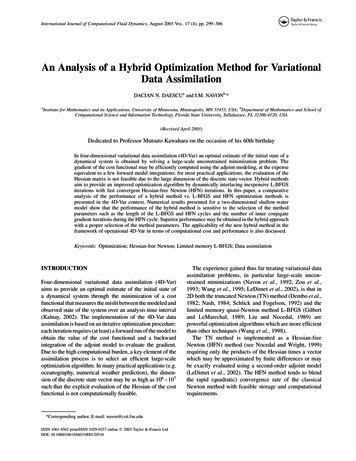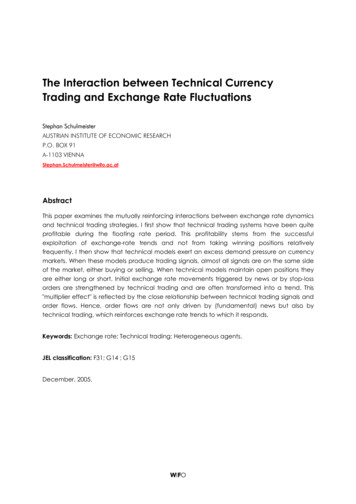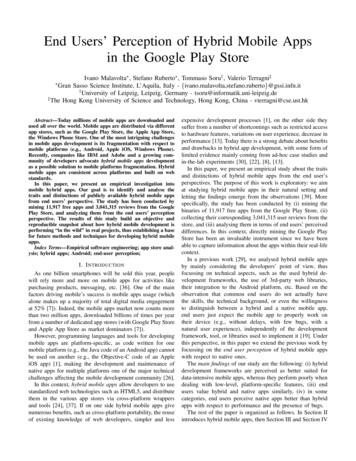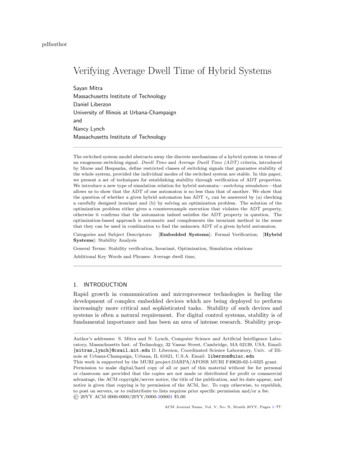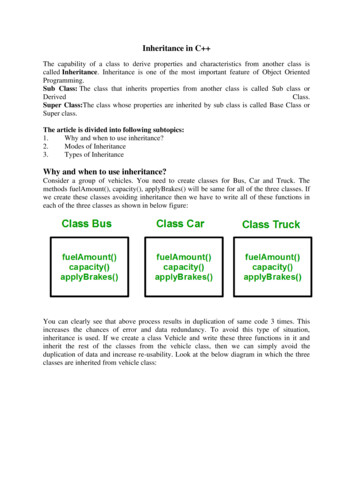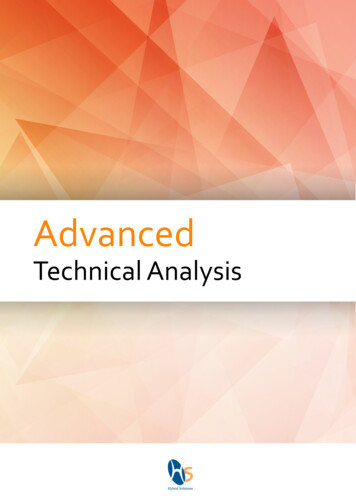
Transcription
AdvancedTechnical Analysis
IndexingLesson1: Moving Average . (02)SIMPLE MOVING AVERAGE (SMA) .(02)EXPONENTIAL MOVING AVERAGE (EMA) .(05)WEIGHTED MOVING AVERAGE (WMA) .(06)Lesson2: BOLLINGER BANDS.(09)Lesson3: MACD Moving Average Convergence Divergence .(11)Lesson4: RSI Rela ve Strength Index .(14)Lesson5: Fibonacci .(16)Fibonacci retracement .(16)Fibonacci Arc . .(17)Fibonacci Fan .(18)
Technical Analysis is a method of evalua ng securi es byanalyzing sta s cs generated by market ac vity, such as pastprices and volume.Technical analysts do not a empt to measure a security'sintrinsic value, but instead use charts and other tools to iden fypa erns that can suggest future ac vity.Technical analysts believe that the historical performance ofstocks and markets are indica ons of future performance.Introduc on to Technical Analysis provides a thoroughgrounding in technical analysis to traders and investmentmanagers of all asset classes who are new to the subject.This course covers the technical analysis, whether from a purelyshort-term ming perspec ve or for longer-term analysis, and isdesigned to get students quickly up to speed and to a levelwhere they can apply TA correctly and confidently in themarkets they cover.1
Lesson 1Moving AverageLesson1: Moving AverageThe defini on of ‘Moving Average’ refers the average value of a security’s price over a given period of me. It is a widely used indicator in technical analysis that helps smooth out price ac on by filteringout the “noise” from random price fluctua ons. A moving average (MA) is a trend-following orlagging indicator because it is based on past prices.There are several uses for moving average (MAs) for people in the trading industry. They are usefulto:1- measure the momentum of price2- ascertain the direc on of the current and future price of security3- define sec ons of possible supports and resistances4- give importance on the direc on of a trend5- reduce the ‘noise’ of price and volume which otherwise may create confusion while analyzing.DIFFERENT TYPES OF ‘MOVING AVERAGE’SIMPLE MOVING AVERAGE (SMA)It is simply the average price of a security at a given period of me. Usually, these are calculated usingclosing prices. The sum of closing prices for the last ten days divided by ten is the Moving Average ofthat security. Naturally, as its name implies, the moving average moves or changes with the pricemovement.Descrip onSMA is the easiest moving average to construct. It is simply the average price over the specifiedperiod. The average is called "moving" because it is plo ed on the chart bar by bar, showing a linethat moves along the chart as the average value changes.2
Moving AverageHow this indicator works SMAs are o en used to determine trend direc on. If the SMA is moving up, the trend is up. If theSMA is moving down, the trend is down. A 200-bar SMA is typically used for the long term trend.50-bar SMAs are typically used to measure the intermediate trend. Shorter period SMAs can be usedto determine shorter term trends. SMAs are commonly used to smooth price data and technical indicators. The longer the period ofthe SMA, the smoother the result, but the more lag that is introduced between the SMA and thesource. Price crossing SMA is o en used to trigger trading signals. When prices cross above the SMA,traders might want to go long or exit short; when they cross below the SMA, traders might want to goshort or exit long.3
Moving Average SMA Crossing SMA is another common trading signal. When a short period SMA crosses above along period SMA, traders may want to go long. Traders may want to go short when the short-termSMA crosses back below the long-term SMA.Calcula onSMA is simply the mean, or average, of the stock price values over the specified period.Assume the Closing prices of a security as: 1, 2, 3, 4, 5, 6, 7, 8, 9, 10, 11, 12, 13, 14, 15. Now, 1st valueof 10 day SMA (Simple Moving Average) will be:1 2 3 4 5 6 7 8 9 10 55/10 5.52nd value of 10 day SMA (Simple Moving Average) will be:2 3 4 5 6 7 8 9 10 11 65/10 6.53rd value of 10 day SMA (Simple Moving Average) will be:3 4 5 6 7 8 9 10 11 12 75/10 7.54th value of 10 day SMA (Simple Moving Average) will be:4 5 6 7 8 9 10 11 12 13 85/10 8.55th value of 10 day SMA (Simple Moving Average) will be:5 6 7 8 9 10 11 12 13 14 95/10 9.54
Moving AverageEXPONENTIAL MOVING AVERAGE (EMA)Descrip onThis moving average focuses more on the recent price movement and hence it is considered as moreresponsive towards than a simple moving average. The calcula on for this is not as simple as thecalcula on for simple moving average [SMA]. It is complicated. VertexFX Trader provides the calcula on of EMA and hence traders can easily concentrate on other implica ons rather than on the calcula ons. EMA turns faster and has less lag than SMA.How this indicator works Use the same rules that apply to SMA when calcula ng EMA. Keep in mind that EMA is generallymore sensi ve to price movement. This can be a double-edged sword. On one side, it can help youiden fy trends earlier than an SMA would. On the other hand, EMA will experience more short-termchanges than SMA. Use the EMA to determine trend direc on, and trade in that direc on. When the EMA rises, tradersmay want to buy when prices comes near or just below the EMA. When the EMA falls, traders mayconsider selling when prices come near or just above the EMA. Moving averages can also indicate support and resistance areas. A rising EMA tends to supportprices, while a falling EMA tends to provide resistance to prices. This reinforces the strategy of buyingwhen the price is near the rising EMA and selling when the price is near the falling EMA. All moving averages, including EMA, are not designed to iden fy a trade at the exact bo om andtop. Moving averages may help you trade in the general direc on of a trend, but with a delay at theentry and exit points. The EMA has a shorter delay than the SMA with the same period.5
Moving AverageCalcula onYou should no ce how the EMA uses the previous value of the EMA in its calcula on. This means theEMA includes all the price data within its current value. The newest price data has the most impacton the Moving Average and the oldest prices data has only a minimal impact.EMA (K x (C - P)) PWhere:C Current PriceP Previous periods EMA (A SMA is used for the first periods calcula ons)K Exponen al smoothing constantThe smoothing constant K, applies appropriate weight to the most recent price. It uses the number ofperiods specified in the moving average.WEIGHTED MOVING AVERAGE (WMA)A Weighted Moving Average puts more weight on recent data and less on past data. This is done bymul plying each bar’s price by a weigh ng factor. Because of its unique calcula on, WMA will followprices more closely than a corresponding Simple Moving Average.6
Moving AverageHow this indicator works WMA is used to help determining trend direc on. It could be an indica on to buy when pricescomes near or just below the WMA. It could be an indica on to sell when prices come near or justabove the WMA. Moving averages can also indicate support and resistance areas. A rising WMA tends to supportprices, while a falling WMA tends to provide resistance to prices. This strategy reinforces the idea ofbuying when price is near rising WMA or selling when price is near falling WMA. All moving averages, including the WMA, are not designed to iden fy trade at the exact bo om ortop. Moving averages tend to validate that the trade is in the general direc on of trend, but with adelay at entry and exit. WMA has shorter delay than SMA. Use same rules that apply to SMA when calcula ng WMA. Keep in mind, WMA is more sensi ve toprice movement. This can be a double-edged sword. On one side, WMA can iden fy trends fasterthan SMA. On the other hand, WMA experience more whipsaws than corresponding SMA.Calcula onThe most recent data is more heavily weighted, and contributes more to the final WMA value.The weigh ng factor used to calculate the WMA is determined by the period selected for the indicator. For example, a 5 period WMA would be calculated as follows:WMA (P1 * 5) (P2 * 4) (P3 * 3) (P4 * 2) (P5 * 1) / (5 4 3 2 1)Where:P1 current priceP2 price one bar ago, etc 7
Moving AverageHow are moving averages used?Moving averages with different me frames can provide a variety of informa on. A longer movingaverage (such as a 200-day EMA) can serve as a valuable smoothing device when you are trying toassess long-term trends.A shorter moving average, such as a 50-day moving average, will more closely follow the price ac on,and therefore is frequently used to assess short-term pa erns. Each moving average can serve as asupport and resistance indicator, and is frequently used as a short-term price target or key level.How exactly do moving averages generate trading signals? Moving averages are widely recognized bymany traders as poten ally significant support and resistance price levels. If the price is above amoving average, it can serve as a strong support level—meaning if the stock does decline, the pricemight have a more difficult me falling below the moving average price level. Alterna vely, if theprice is below a moving average, it can serve as a strong resistance level—meaning if the stock wereto increase, the price might struggle to rise above the moving average.8
Lesson 2Bollinger BandsLesson2: BOLLINGER BANDSDescrip onBollinger Bands are types of price envelope that was developed by John Bollinger. (Price envelopesdefine upper and lower price range levels.) Bollinger Bands are envelopes plo ed at a standarddevia on level above and below a simple moving average of the price. Because the distance of thebands is based on standard devia on, they adjust to vola lity swings in the underlying price.Bollinger Bands use 2 parameters, Period and Standard Devia ons, StdDev. The default values are 20for period, and 2 for standard devia ons.Bollinger bands helps determining if prices are high or low on a rela ve basis. They are used in pairs,both upper and lower bands in addi on to a moving average. Further, the pair of bands is not intended to be used alone. Use the pair to confirm signals given with other indicators.How this indicator works When the bands narrow during a period of low vola lity, it boosts the probability of an intenseprice movement in either direc on. This may start new trend move. We should be careful for falsemove in opposite direc on which reverses before the proper trend begins.9
Bollinger Bands When the bands separate by an unusual large amount, vola lity increases and any exis ng trendmay be ending. Prices have a tendency to bounce between the bands’ envelope. You can use these swings to helpiden fy poten al profit targets. For example, if a price bounces off the lower band and then crossesabove the moving average, the upper band then becomes the profit target. Price can exceed or hug the band envelope for long periods through strong trends. Traders maywant to do addi onal researches to determine if taking addi onal profits is applicable. A strong trend con nua on can be expected when the price moves out of bands. However, if pricesmove instantly back inside the bands, then the suggested strength is revoked.Calcula onAt first, calculate a simple moving average. Next, calculate the standard devia on over the same numberof periods as the simple moving average. For the upper band, add the standard devia on to the movingaverage. For the lower band, subtract the standard devia on from the moving average.Typical values used:20 day moving average, bands at 2 standard devia ons. (2 mes the standard devia on. /- the SMA).Middle Band 20 Day Simple Moving AverageUpper Band 20 Day Simple Moving Average (20 day Simple Moving Average Standard Devia on x 2)Lower Band 20 Day Simple Moving Average - (20 day Simple Moving Average Standard Devia on x 2)VertexFX is used for the calcula on of the Bollinger Bands and for applying it on the chart by many technical analysis and traders.10
Lesson 3MACD Moving AverageConvergence DivergenceLesson3:MACD Moving Average Convergence DivergenceDescrip onMACD, short for moving average convergence divergence, is a trading indicator used in technicalanalysis of stock prices, created by Gerald Appel in the late 1970s. It reveals changes in thestrength, direc on, momentum, and dura on of a trend in a security price.MACD indicator is a momentum oscillator used to trade trends. Although it is an oscillator, it is nottypically used to iden fy over bought or oversold condi ons. On the chart it appears as two linesthat oscillates without boundaries. The intersec on of the two lines provides trading signals.The concept behind the MACD is very easy; it calculates the difference between a security 26-dayand 12-day exponen al moving averages (EMA). One of the two moving averages that is constructing the MACD, the 12-day EMA is the faster one, while the 26-day is the slower. In the calcula onof their values, both moving averages use the closing. When a aching the MACD on chart suingVertexFX, a nine-day EMA of the MACD itself is plo ed as well, and it acts as a signal provider forbuy and sell decisions. The MACD generates a buy signal when it moves above its own nine-dayEMA, and it generates a sell sign when it moves below its nine-day EMA.The Three Major Components1 The MACD LineMACD Line is a result of taking a longer term EMA and subtrac ng it from a shorter term EMA.The most commonly used values are 26 days for the longer term EMA and 12 days for the shorterterm EMA, but it is the trader's choice.2 The Signal LineThe Signal Line is an EMA of the MACD Line described in Component 1.The trader can choose what period length EMA to use for the Signal Line however 9 is the mostcommon.3 The MACD HistogramAs me advances, the difference between the MACD Line and Signal Line will con nually differ. TheMACD histogram takes that difference and plots it into an easily readable histogram. The differencebetween the two lines oscillates around a Zero Line.When the MACD histogram is above the Zero Line, the MACD is considered posi ve and when it isbelow the Zero Line, the MACD is considered nega ve.11
MACD Moving AverageConvergence DivergenceHow MACD indicator works When the MACD crosses above the zero line, then it is considered bullish signal (signal to buy),while when the MACD crosses below the zero line, then it is considered bearish signal (signal to sell). When the MACD elevates from below the zero then it is considered a bullish signal. On the contrary,when it demotes from above the zero then it is considered a bearish signal. When the MACD line crosses from below to above the signal line, the indicator is consideredbullish. When the MACD line crosses from above to below the signal line, the indicator is consideredbearish. During trading ranges the MACD might whipsaw, with the MACD line crossing across the signal line.Trader who uses the MACD generally avoids trading in this case or closes posi ons to reduce losswithin their accounts. Divergence between MACD and price ac on is a stronger signal when it confirms the crossoversignals.12
MACD Moving AverageConvergence DivergenceDIVERGENCE Divergence is another signal created by the MACD. Simply put, divergence is when the MACD andactual price are not in agreement. For example, Bullish Divergence occurs when price records a lower low, but the MACD records ahigher low. The movement of price can provide evidence of the current trend, however changes inmomentum as evidenced by the MACD can some mes precede a significant reversal.What makes the MACD such a valuable tool for technical analysis is that it is two indicators in one. Itcan help to iden fy trends, and it can measure momentum as well. It takes two separate laggingindicators and adds the aspect of momentum which is much more ac ve or predic ve. That kind ofversa lity is why it has been and is used by traders and analysts.Despite MACD's obvious a ributes, just like with any indicator, the trader or analyst needs to exercisecau on. There are just some things that MACD doesn't do well which may tempt a trader regardless.Most notably, traders may be tempted into using MACD as a way to find overbought or oversoldcondi ons. This is not a good idea. Remember, MACD is not bound to a range, so what is consideredto be highly posi ve or nega ve for one instrument may not be good to a different instrument.Calcula onAn approximated MACD can be calculated by subtrac ng the value of a 26 period Exponen al MovingAverage (EMA) from a 12 period EMA. The shorter EMA is constantly converging toward, and diverging away from, the longer EMA. This causes MACD to oscillate around the zero level. A signal line iscreated with a 9 period EMA of the MACD line.Note: The sample calcula on above is the default. You can adjust the parameters based upon yourown criteria.MACD: (12 day EMA – 26 day EMA)Signal Line: 9 day EMA of MACDMACD Histogram: MACD - Signal Line13
Lesson 4RSI Rela ve Strength IndexLesson4: RSI Rela ve Strength IndexDescrip onThe Rela ve Strength Index (RSI), developed by J. Welles Wilder, is a momentum oscillator thatmeasures the speed and change of price movements. RSI oscillates between zero and 100.According to Wilder, RSI is considered overbought when above 70 and oversold when below 30.Signals can also be generated by looking for divergences, failure swings and centerline crossovers. RSIcan also be used to iden fy general trend.How RSI indicator works RSI is considered overbought when above 70 and oversold when below 30. RSI also o en forms chart pa erns that may not show on the price chart, such as double tops andbo oms and trend lines. Also, look for support or resistance on the RSI. In an uptrend RSI tends to remain between 40 to90 range with the 40-50 zone ac ng as support.During downtrend RSI tends to stay between the 10 to 60 range with the 50-60 zone ac ng as resistance. If security prices made new high or low that isn't confirmed by the RSI, this divergence can signal aprice reversal. If the RSI makes a lower high and then follows with a downside move below a previouslow, a Top Swing Failure has occurred. If the RSI makes a higher low and then follows with an upsidemove above a previous high, a Bo om Swing Failure has occurred.14
RSI Rela ve Strength IndexCalcula onThe RSI is a fairly simple formula, but is difficult to explain without pages of examples. Use the VertexFX trader to help you see a visual and use RSI. The basic formula is:RSI 100 – [100 / ( 1 (Average of Upward Price Change / Average of Downward Price Change ) )15
Lesson 5FibonacciLesson5: FibonacciIn mathema cs, the Fibonacci numbers are the numbers in the following sequence, called theFibonacci sequence, and characterized by the fact that every number a er the first two is the sum ofthe two preceding ones:0, 1, 1, 2, 3, 5, 8, 13, 21, 34, 55, 89, 144, .In short, Fibonacci numbers or ra os are mathema cally significant numbers that occur all liferaspects. Fibonacci numbers were discovered by Leonardo de Pisa. The most important number orra o is the 61.8% or .618 levels. There is also a 1.618 Extension along with 2.618. In trading, Fibonacci retracements can iden fy poten al support / resistance levels.Fibonacci retracementDescrip onFibonacci retracement plots percentage retracement lines based on the mathema cal rela onship inthe Fibonacci sequence. Retracement levels provide support and resistance levels.Fibonacci Retracements are displayed by drawing a trend line between two extreme points. A seriesof horizontal lines are drawn intersec ng the trend line at Fibonacci levels between 0.0%, and 100%.16
FibonacciHow Fibonacci retracement works Retracements show possible support or resistance areas, 23.6%, 38.2%, 50%, 61.8%, and 100%. According to market direc on, prices will retrace a big por on of the previous trend prior resumingin the move in the original direc on.Calcula onFibonacci numbers are a sequence of numbers in which each successive number is the sum of thetwo previous numbers:1, 1, 2, 3, 5, 8, 13, 21, 34, 55, 89, 144, 233, and so on.The key Fibonacci ra o is 61.8% - also known as "the golden ra o"- is found by dividing one numberin the series by the number that follows it. For example: 8/13 0.6153, and 55/89 0.6179.The 38.2% ra o is found by dividing one number in the series by the number that is found two placesto the right. For example: 55/144 0.3819.The 23.6% ra o is found by dividing one number in the series by the number that is three places tothe right. For example: 8/34 0.2352.Fibonacci ArcDescrip onFibonacci Arcs are half circles that extend out from a trend line drawn between two points. Half arcsare drawn, measured from the second extreme point, so they intersect the trend line at the Fibonaccilevels. These arcs mark support and resistance areas as prices retrace a por on of their move a er adecline or an advance.17
FibonacciHow Fibonacci Arcs worksAn cipate support / resistance as price approaches Fibonacci Arcs.A er the significant bear market, the rally was stopped by the 50% arc; the 50% arc retracementacted as resistance, 38.2% arc than gave support, bouncing between the 50% arc and the 38.2% arcfor many months. A er price broke through the resistance arc at 50%, price moved up to the nextsignificant Fibonacci ra o, 61.8%, where it found a new resistance level. The prior resistance level at50%, a er being broken, became a new support level. The next Fibonacci arc was at 100%, whereprice met resistance.Calcula on Base Line: A line from point A to point B First Arc: Radius 23.6% of base line Second Arc: Radius 38.2% of base line Third Arc: 61.8% of base line.Fibonacci FanDescrip onFibonacci Fan Lines are displayed by drawing a trend line between two points. Then an "invisible"ver cal line, equal to the ver cal distance between the extreme points, is drawn from the secondextreme point to the level of the first extreme point. Four trend lines are then drawn from the firstextreme point so they pass through the invisible ver cal line at the Fibonacci levels of 23.6%, 38.2%,50.0%, and 61.8%.18
FibonacciHow this indicator worksAn cipate support / resistance as price approaches Fibonacci Fan Lines.So we have the following at the end of the trace: Rising fan lines which pass from a trough along the various retracement levels to the peak. Thesefan lines serve primarily as support levels for rising prices, or resistance when a par cular line hasbeen broken downwards. Falling fan lines which head down from a peak along the retracement levels and get down to atrough. These fan lines can serve as resistance levels.Fibonacci fans are trend lines which extend in the shape of a fan either upwards or downwards.These trend lines correspond to the Fibonacci retracement levels. The only difference between theFibonacci fans and Fibonacci retracement levels is the direc on of the lines. Two Fibonacci fans arerecognized:- Rising Fibonacci FanThe fan lines are seen as follows: Fan Line 1: Price trough to 38.2% retracement level Fan Line 2: Price trough to 50% retracement level Fan Line 3: Price trough to 61.8% retracement level- Falling Fibonacci FanThe fan lines are seen as follows: Fan Line 1: Price peak to 38.2% retracement level Fan Line 2: Price peak to 50% retracement level Fan Line 3: Price trough to 50% retracement level19
FibonacciCalcula onRising Fibonacci Fan Fan line 1: Drawn from extreme low through 23.6% retracement level Fan line 2: Drawn from extreme low through 38.2% retracement level Fan line 3: Drawn from extreme low through 50% retracement level Fan line 4: Drawn from extreme low through 61.8% retracement level Falling Fibonacci Fan Fan line 1: Drawn from extreme high through 23.6% retracement Fan line 2: Drawn from extreme high through 38.2% retracement Fan line 3: Drawn from extreme high through 50% low retracement Fan line 4: Drawn from extreme high through 61.8% retracement20
Contact us 44-2-071-936-008 61-280-114-343 1-845-657-3272 852-8199-0933 962-6-552-0822Copyrights of Hybrid Solu ons - Hybrid Solu ons 2017www.hybridsolu ons.com
SMAs are commonly used to smooth price data and technical indicators. The longer the period of the SMA, the smoother the result, but the more lag that is introduced between the SMA and the source. Price crossing SMA is




